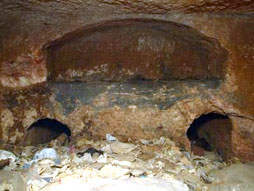By André Green/se news editor

The world’s three dominant religions—Christianity, Judaism and Islam—have many similarities, and one man’s documentary could quite possibly affect the thinking of believers around the world.
Award-winning documentary filmmaker Simcha Jacobovici believes he may have found evidence that sheds light on what happened to Jesus of Nazareth post-crucifixion.
The documents that provide the foundations for world religions may now face re-evaluation from the discovery of what may now be Jesus’ tomb.
From creation to the great flood to the final judgment of man, the Tanakh, Scriptures and Sura encourage followers to believe in the words of their respective texts through faith.
Noah’s Ark, the Garden of Eden and the Ark of the Covenant, to name a few, have not been discovered, yet spiritual leaders encourage their congregations to believe in a higher being, regardless of physical evidence.
But physical evidence may have been found, as reported in the documentary The Lost Tomb of Jesus, which details the discovery of the remains of a box presumably bearing the name “Yeshua bar Yehosef”-—Jesus Son of Joseph.
Tomb Discovery
According to Lost Tomb, in spring 1980, an Israeli construction team was razing land for a housing development in Jerusalem’s southeastern suburb of Talpiot. As the team was clearing away the hillside, an ancient burial tomb was unearthed.
A young boy and his friend were curious about the construction site and went to investigate.
They noticed the dynamite blasting by the crew had exposed a tomb with an odd set of symbols on the entrance.
One of the boys told his mother and asked her to intervene to keep the crew from destroying the tomb.
An archaeological team arrived and began mapping the tomb and removed 10 ancient limestone coffins, or ossuaries.
Shimon Gibson, one of the first archaeologists on the site, recalled marveling at the symbols on the tomb’s entrance prior to surveying it.
Although Gibson was not sure of the meaning of the symbols, he thought the ornamentation highly improbable on a simple tomb.
“ It’s unlikely that the person or the family that came to carve out the tomb just carved these things at random,” he said. “They had to symbolize something.”
Under the direction of the Israel Antiquities Authority, the ossuaries were transferred to Israel’s Rockefeller Museum, where they were cataloged and prepared for reburial at the request of the Orthodox Jewish community.
During the cataloging, marks first thought to be random scratches and wear and tear on the coffins were believed to be the ancient names of the deceased.
Regardless, the ossuaries provided archaeologists with a catalog of names relative to the time of Jesus.
Nearly 27 years later, Jacobovici, with the help of Titanic director James Cameron, investigated the findings of the ancient tomb.
Many dissenting scholars and archeologists have suggested that Jacobovici’s investigation was purely an over-advertised, romanticized archaeological scheme.
Critics have said the excavation resembled CSI: Jerusalem because it takes longer than a two-hour time slot to substantiate findings and add a variety of opinions to the equation.
Others weighed in on Cameron’s involvement with the project believing it was more Hollywood hype than significant discovery.
Contradictions
Dr. Jodi Magness, professor of religious studies at the University of North Carolina at Chapel Hill, believes Jacobovici’s findings are unequivocally false.
Magness, in The Society of Biblical Literature, said money and status were the ultimate deciding factor in a person’s burial in ancient Jerusalem. She cites time (the Gospels were written 30-50 years after Jesus’ death) and some inaccuracies in the canonical Gospels as the basis for her argument.
Magness said since Jesus came from a poor family, it would be nearly impossible for him to be buried and remain in a stone tomb his family could not afford.
She also said the family, if they indeed possessed a tomb, would have it in Nazareth, not Jerusalem.
The body of Jesus was placed in the tomb of Joseph of Arimathea because of time constraints as the Sabbath approached. When the Sabbath passed, the body would have been placed in a rectangular grave, similar to today’s burials, Magness said.
Because he was buried, Magness argues, there would be no ossuary containing the remains of Jesus of Nazareth.
Additionally, Magness said Jacobovici and Cameron’s announcement to the press circumvented the academic process of archaeology.
“ Archaeology is a scientific discipline,” she said. “New discoveries and interpretations typically are presented in scientific venues such as professional meetings or are published in peer-reviewed journals, where they can be considered and discussed by other specialists.”
Professional Support
But others, such as Dr. James D. Tabor, view the findings in a different light.
Tabor, department chair of religious studies at the University of North Carolina at Charlotte, believes the tomb is real.
Responding to Magness’ comments, Tabor wrote in The Society of Biblical Literature, that, following the Sabbath, Joseph of Arimathea most likely moved the body of Jesus.
And because Jesus and his movement were so popular, there very well could have been a tomb to which the body was relocated as was the case for John the Baptist, he wrote.
Tabor contends that even if Jesus were poor, his followers would have provided for him and, thus, would have included his family.
Tabor added that the tomb was modest and was sufficient to house the remains Jesus and his family.
“ It is nothing like the more monumental decorated tombs closer to the city,” he said.
“ I am not convinced that the mere existence of a modest rock-hewn tomb of this type indicates high status and wealth.”
Tomb Closure
After two days of filming and examination of the Talpiot tomb, Jacobovici was asked to leave the location because he failed to obtain the proper clearance from the Israeli Antiquities Authority.
The tomb was sealed as the credits rolled on Lost Tomb, and perhaps the world will never know what lies beneath an apartment building and centuries of earth.
























